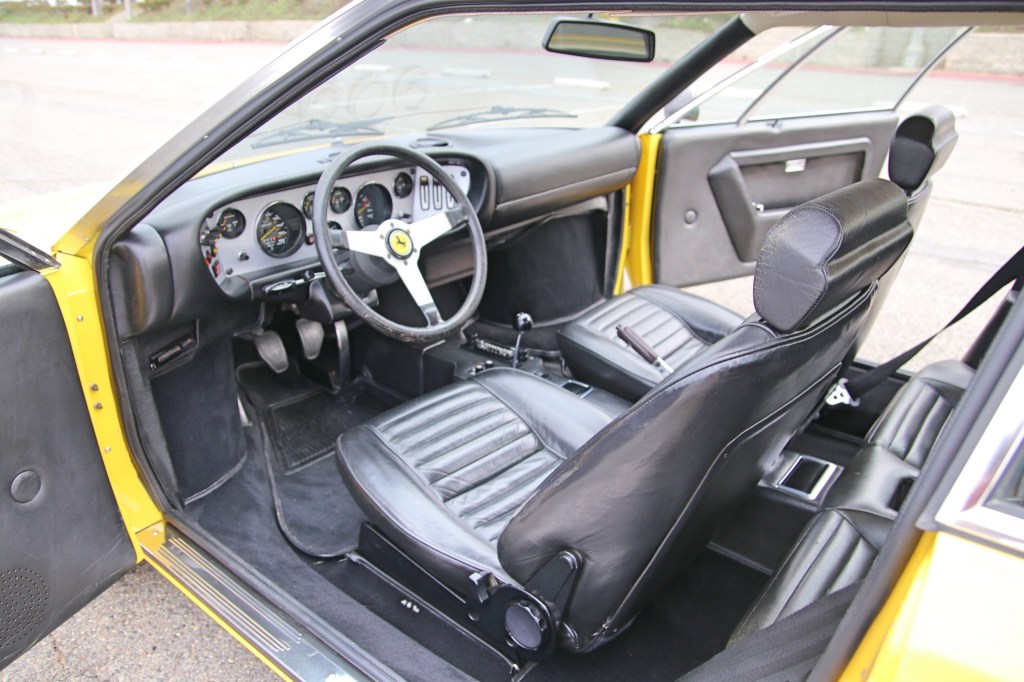
The 308 GT4 Is the Best-Kept Cheap Secret of Classic Ferraris
Although buying a new Ferrari comes with precarious political strings attached, that’s not the case with classic models. Further, although many vintage Ferraris often sell for more than new ones, there are some priced at more attainable levels. Better yet, there’s one classic affordable Ferrari that’s usually forgotten about. Enter the Ferrari 308 GT4—a classic definitely worth your consideration.
What makes the Ferrari 308 GT4 unique?
Initially, The Drive reports, the Ferrari 308 GT4 wasn’t actually, technically, a Ferrari. It was badged ‘Dino’, after Enzo Ferrari’s late son. As the classic model didn’t have a V12, it wasn’t considered a ‘true’ Ferrari. However, Ferrari eventually abandoned that tactic and told dealers to replace the Dino badges with Ferrari ones.
The original lack of a classic Ferrari badge may also explain the 308 GT4’s styling. Traditionally, Ferraris have been styled by Italian firm Pininfarina. In fact, Pininfarina did design the rest of the 308 models. The GT4, though, was designed by Bertone, the firm behind legends like the Lamborghini Countach and Lancia Stratos. But that’s not the 308 GT4’s only claim to fame.
The first Dino, the 246, was Ferrari’s first road-going mid-engine car. However, as GM did with the 2020 Corvette, Ferrari worried that customers wouldn’t be able to properly deal with a mid-engine car’s handling. As a result, that car only came with a V6 mill.
The 308 GT4, though, featured Ferrari’s first-ever production V8, a 2.9-liter developing approximately 240 hp. And, despite its mid-engine layout, it’s also the first Dino 2+2. Also, because it didn’t have emissions equipment like the later (and higher-priced) 308 GTB, owner and veteran automotive journalist Jason Cammisa reported on The Smoking Tire podcast, it’s actually faster and lighter than the later car. But more impressive than the performance is the Ferrari 308 GT4’s day-to-day usability.
The Ferrari 308 GT4 is fairly reliable and daily-drivable
True, as with any older car, unrestored classic Ferrari 308 GT4s can develop some quirks and issues. The 2.9-liter V8 has 4 carburetors, and they can be difficult to sync. And, as Classic & Sports Car reports, some GT4-unique parts can be a little expensive. Overall, though, these cars are fairly robust. That said, there are really only 3 things to look out for.
The first is that the original sodium-filled valves can break, which requires an engine rebuild. However, almost all GT4s have had these valves replaced by now. Secondly, the car’s original distributors can be difficult to maintain, although the answer is simply replacing them with electronic ones. Finally, while the Ferrari 308 GT4 was made from 1973-1980, pre-1978 cars can suffer from plugged spark plugs, which are fixed by retro-fitting electronic ignition packs.
Usually, though, the 308 GT4 just needs to be driven. With that and regular maintenance, these cars are generally reliable. In fact, their qualities may tempt some into using them as daily drivers. The 308 GT4 has excellent visibility—more so than the later GTB. The seats are comfortable, and there’s enough headroom even for people over six feet tall. The car has four-wheel disc brakes that feel almost modern, and the mid-engine layout with independent suspension all around means the GT4 handles well.
So, what about pricing?

On Bring a Trailer (BaT), the vast majority of 308 GT4s sell for $40,000 to $60,000. However, prices may vary dependent on location, mileage, and condition. Compare that to the earlier, curvier 246 Dino, which sells for closer to $300,000. Also, compare it to the later 1985 308 GTSi Quattrovalvole, one of which sold in March 2020 on BaT for $80,000.
Obviously, as with any used car purchase, especially a used classic car, we recommend giving the car you’re interested in to a trusted mechanic for an inspection. But, when it comes to the 308 GT4, you’re getting a classic Ferrari experience without having to break the bank.
Editor’s note: Matthew Skwarczek contributed to this article.



